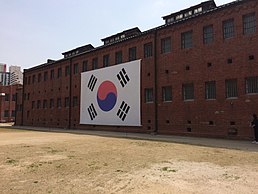Seodaemun Prison
 View of Seodaemun Prison History Hall from the Seodaemun Independence Park | |
 | |
| Established |
|
|---|---|
| Type | Memorial museum |
| Seodaemun Prison | |
| Hangul | 서대문형무소역사관 |
|---|---|
| Hanja | 西大門刑務所歷史觀 |
| Revised Romanization | Seodaemun Hyeongmuso Yeoksagwan |
| McCune–Reischauer | Sŏdaemun Hyŏngmuso Yŏksakwan |
| Original name | |
| Hangul | 경성감옥 |
| Hanja | 京城監獄 |
| Revised Romanization | Gyeongsong Gamok |
| McCune–Reischauer | Kyŏngsŏng Kamok |
| Other names | |
| Hangul | 서울형무소
서울교도소 서울구치소 |
| Hanja | 서울刑務所
서울矯導所 서울拘置所 |
| Revised Romanization |
|
| McCune–Reischauer |
|
Literal translations:
| |

Seodaemun Prison History Hall (Korean: 서대문형무소역사관) is a museum and former prison in Seodaemun District, Seoul, South Korea. It was constructed beginning in 1907.
The prison was opened on October 21, 1908, under the name Gyeongseong Gamok. During the early part of the Japanese colonial period it was known as Keijo Prison[1] (Keijō Kangoku). Its name was changed to Seodaemun Prison in 1923, and it later had several other names.[2]
History
The prison was used during the
Shortly before the end of the colonial period in 1945, the number of prisoners was 2980.[5] After liberation, the prison was used by the South Korean government, and was known by various official names, including Seoul Prison until 1961, Seoul Correctional Institute until 1967 and Seoul Detention Center until its closure in 1987. It was replaced by a facility in Uiwang City, Gyeonggi Province.[6]
In 1992, the site was dedicated as the Seodaemun Prison History Hall, part of Seodaemun Independence Park. Seven of the prison complex's original fifteen buildings are preserved as historical monuments. The History Hall covers topics related to the prison during the Japanese colonial period and continues to serve as a memorial hall.[7]
During a visit to Seodaemun in August 2015, former Japanese prime minister Yukio Hatoyama knelt in front of a memorial stone as an expression of apology for Japanese war crimes in World War II.[8]
Location

See also
- Korea under Japanese rule
- Gyeonggyojang
- Museum of Japanese Colonial History in Korea
- Independence Gate
References
- ^ Annual Report on Reforms and Progress in Chosen. Government-General of Korea. 1923.
- ISBN 9783319663388.
- ^ a b Joel Lee (August 2, 2018). "Former prison lives with vestiges of Korea's patriotic past". The Korea Herald. Retrieved May 21, 2019.
- ISBN 9781134046454.
- ISBN 9784582702651.
- ^ "인왕산 도성탐방기<2>서대문형무소역사관, 국사당, 선바위". The Hankyoreh. May 9, 2017. Retrieved May 13, 2018.
- ^ "Korea". 2013.
- )
